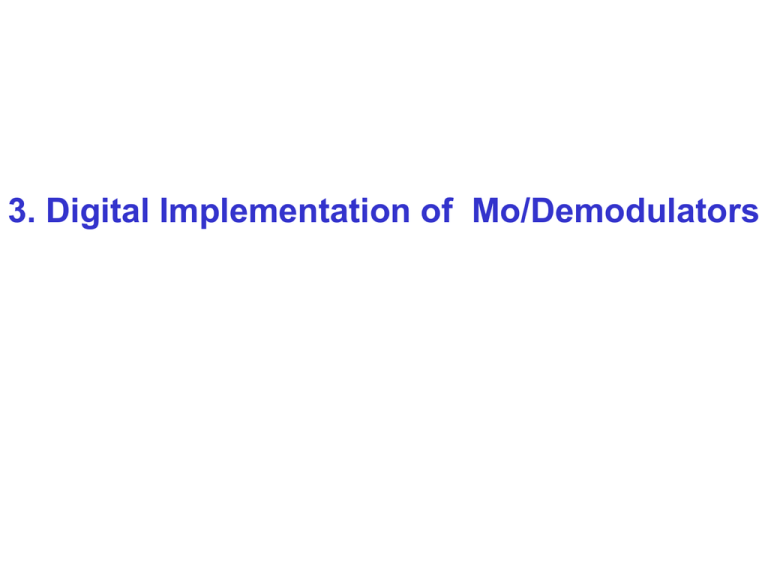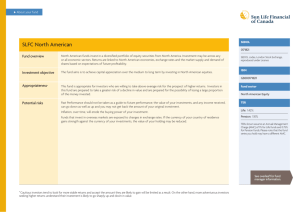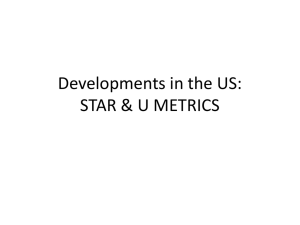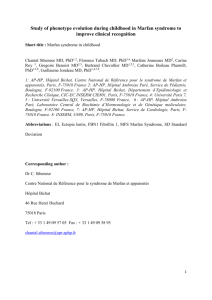3-Modem Implementation
advertisement

3. Digital Implementation of Mo/Demodulators
General Structure of a Mo/Demodulator
DSB
X (F )
x(t )
d (t )
D(F )
F
dˆ (t )
MOD
SSB
FC
DEM
FC F
amp
amp
X (F )
FC F
Single Side Band (SSB) Modulator
MOD
D(F )
d (t )
d (t )
Re{.}
SSB
F
x(t )
X (F )
D (F )
e j ( 2FC t )
F
FC F
Implementation using Real Components
cos2FCt
d R (t )
d (t )
SSB
d I (t )
sin 2FC t
where
d R (t ) Red (t )
d I (t ) Imd (t )
x(t )
Single Side Band (SSB) Demodulator
DEM
D(F )
d (t )
x(t )
LPF
F
cos2FC t
X (F )
FC F
Single Side Band (SSB) Modulator in Discrete Time
Modulator Implemented in two stages:
Digital Up
Converter
d (t )
d [n]
Fs
DUC
M
s (t )
s[n]
ZOH
MFs
Fs
~ FIF
DISCRETE TIME
Analog
MOD
x(t )
~ FC FIF
CONTINUOUS TIME
Single Side Band (SSB) Demodulator in Discrete Time
Demodulator Implemented in two stages:
Digital Down
Converter
y(t )
Analog s (t )
DEM
~ FC FIF
CONTINUOUS TIME
s[n]
DDC
M
d (t )
d [n]
Fs
MFs
~ FIF
DISCRETE TIME
ZOH
Digital Down (DDC) and UP (DUC) Converters
D( f )
1
2
Fs
2
d [n]
DUC
s[n]
Fs
M
MFs
12
~ FIF
f
F
d [n]
Fs
DDC
M
S( f )
f IF
s[n]
MFs
RF
Baseband
• kHz for voice
• MHz for voice
• MHz for data
• GHz for data
Order of magnitude of resampling: M ~ 1,000
1
2
f
MFs
2
F
Problem with Large Upsampling Factor
D
F
Fs
d [n]
BF
s[n]
M
LPF
s
2
LPF
MFs
2
if M is large, very small transition region
Fs
Fs B
B
MFs
2
f
Fs 2 B
MFs
1M2b
high complexity filter
Problem with Large Downsampling Factor
S
F
Fs
BF
s[n]
LPF
M
d [n]
s
2M
LPF
MFs
2
Fs
M
B
B
Fs
M
if M is large, very small transition region
Fs
2
f
Fs / M 2 B
Fs
1
M
2b
high complexity filter
Solution: Upsample in Stages
In order to make it more efficient we upsample in L stages
x0 [n] d[n]
F0 Fs
M1
F1
H1 ( z)
xL [mL ] y[m]
x2 [m2 ]
x1[m1 ]
M2
F2
H 2 ( z)
ML
M M1 M 2 ... M L
FL
H L (z )
MFs FL
i-th Stage of Upsampling
X i 1
F
Fi1
xi 1[mi 1 ]
Mi
B
xi [mi ]
Fi
F
Fi
Fi
H i (F )
f i
Hi ( z )
Fi 1
Fi1 2 B
Fi
Xi
F B
i1
B
Fi
2
Example: Upsample in One Stage
D
F
F0
y[m]
F (kHz) d [n]
4
96
H (z )
F3 1.152MHz
F0 12kHz
8
f 112,152
N
50
22
1
288
288 656
N Fs 755.7 106 ops / sec
This is not only a filter with high complexity, but also it is
computed at a high sampling rate.
Same Example in Three Stages
D
4
F
F0
F (kHz)
d [n]
F0 12kHz
2
F1 24kHz
f1 12248
N1
4
H1 ( z)
50
22
1
6
6 14
N1 Fs1 336103
H 2 ( z)
N2
24 8
96
50
22
12
H3 ( z)
F3 1.152MHz
F2 96kHz
f 2
x3[m3 ] y[m]
x2 [m2 ]
x1[m1 ]
1
6
6 14
N 2 Fs 2 1.34 106
f 3
96 8
1152
N3
50 144
22 11
11
144
30
N 3 Fs 3 34.5 106
Total Number of operations/sec= 36.176106
a 95% savings!!!!
Downsample in Stages
x1[m1 ]
x0 [n] d[n]
F0 Fs
H0 ( z)
F0
M1
H1 ( z)
xL [mL ] y[m]
x2 [m2 ]
F1
H L1 ( z)
M2
F2
M M1 M 2 ... M L
FL1
ML
Fs
FL
M
i-th Stage of Downsampling
X
Fi 1
2
Xi
F
i 1 Fi1
noise
B
F
Fi
Fi
Fi 1
2
xi 1[mi 1 ]
Hi 1 ( z)
xi [mi ]
Mi
Fi 1
Fi
Hi 1 ( F )
fi
Fi 2 B
Fi 1
B
Fi B
Fi 1
2
B
Fi
keep aliased noise
away from signal
Example: Downsample in One Stage
D
F
F0
y[m]
F (kHz) d [n]
4
H (z )
F0 2.4MHz
8
f 12
2400
N
50
22
200
F1 12kHz
1
600
600 1,364
N F0 3.273 109 ops / sec
Same Example in Three Stages
D
F
F0
F (kHz)
y[m]
4
d [n]
H0 ( z)
4
F0 2.4MHz
f 0
600 8
2400
N0
50
22
H1 ( z)
5
F1 600kHz
1
4.05
4.05 10
N 0 F0 24 10
6
8
f1 120
600
N1
50
22
10
H2 ( z)
F2 120kHz
1
5.36
5.36 13
N1F1 7.8 106
f 2 121208
N2
50
22
1
30
30 68
N 2 F2 8.16 106
6
39.96
10
Total Number of operations/sec =
… a savings of almost 99% !!!
F3 12kHz
Stages at the Highest Rates
d [n]
y[m]
F0 Fs
M1
M L 1
H1 ( z)
H L1 ( z)
FL1
ML
FL
H L (z )
MFs FL
highest rates
d [n]
F0 Fs
y[m]
H0 ( z)
F0
H1 ( z)
M1
F1
M2
H L1 ( z)
ML
Fs
FL
M
• the highest sampling rates are close to carrier frequencies, thus very
high;
• properly choose intermediate frequencies to have simple filters at
highest rates
Last Stage in UpSampling
y[m]
xL1[n]
ML
FL1
FL
H L (z )
MFs FL
2B FL1 FL
X L1
F
FL1
FL1
B
wide region F B
L 1
First Stage in DownSampling
x1[m]
d [n]
F0 Fs
H0 ( z)
F0
M1
F1
F0 F1 2B
X1
F
F1
F1
B
wide region F B
1
Very simple Low Pass Filter: the Comb Integrator Cascade
(CIC)
x[n]
N 1
1 z 1 ... z ( N 1)
y[n] x[n ]
0
same!!!
x[n]
1 zN
1
1 z 1
“Comb”
“Integrator”
y[n] y[n 1] x[n] x[n N ]
y[n]
y[n] x[n ]
these two are the same!
Notice: no multiplications!
N 1
0
Frequency Response of the Comb Filter
1 zN
z e j 2
f
1 e j 2 N f e j N f e j N f e j N f
2 je j N f sin N f
1 e j 2 N f
2
N
1
N
1
N
2
N
…like a comb!
3
N
f
Impulse Response of the CIC
[n]
N
1 z
1 z 1
N
[n]
c0[m]
interpolating sequence
c0[m]
[m]
N 1
c0 [m] [m ]
0
0
N 1
The CIC in the Time Domain
x[n]
N
N
x[n]
s[m]
s[m]
x[] [m N ]
like a discrete time ZOH!
1 z
1 z 1
y[m]
y[m]
y[m]
x[]c [m N ]
0
Two Important Identities: The “Noble” Identities
x[n]
x[n kN ]
z kN
y[m] x[m N kN ]
N
Same !!!
x[m N]
x[n]
N
z
k
y[m] x[(m k ) N ]
As a consequence we have one of two “Noble Identities”:
x[n]
H z
N
y[m]
N
Same!!!
x[n]
N
H z
y[m]
Other “Noble” Identity
y[m kN ]
y1[m kN ]
y1[m]
x[n]
z kN
N
x[n] [m kN nN]
n
Same !!!
x[n k ]
x[n]
z
k
N
y2 [m]
x[n k ] [m nN]
n
As a consequence we have the other of the two “Noble Identities”:
x[n]
N
H zN
y[m]
x[n]
H z
y[m]
N
Efficient Implementation of Upsampling CIC
x[n]
N
1 z
1
1 z 1
N
y[m]
Use Noble Identity:
x[n]
1 z
1
1 z 1
N
1
y[m]
Very simple implementation (no multiplications):
x[n]
z
1
y[m]
N
z 1
Efficient Implementation of Downsampling CIC
x[n]
y[m]
1
1 z 1
1 zN
N
Use Noble Identity:
x[n]
y[m]
1
1 z 1
N
1 z 1
Very simple implementation (no multiplications):
y[m]
x[n]
N
z
1
z
1
Frequency Response of the CIC
5
0
dB
-5
only 13 dB attenuation
-10
-15
-20
-25
0
0.1
0.2
0.3
0.4
0.5
f=F/Fs
f PASS
f STOP
Not a very good Low Pass Filter. We want a better attenuation in the
stopband!
Put M Stages together
x[n]
1 zN
1 z 1
N
x[n]
1 z
1 z 1
N
y[m]
M
y[m]
M
N
Frequency Response:
CM 1 ( f )
j 2 N f
1 e
1 e j 2 f
j ( N 1) Mf sin N f
e
sin f
M
Improved Frequency Response of CIC Filter
Resampling Factor N=10
0
-10
-20
M 2
dB
-30
M 3
-40
M 4
-50
M 5
-60
-70
-80
0
0.1
0.2
0.3
0.4
f=F/Fs
With M=4 or 5 we already get a very good attenuation.
0.5
0
-2
-4
-6
-8
0
0.005
0.01
0.015
0.02
f=F/Fs
0.025
0.03
0.035
0.04
0
-10
-20
-30
dB
dB
Example: M=4 Stages
-40
-50
-60
-70
-80
0
0.1
0.2
0.3
f=F/Fs
0.4
0.5
Implementation of M Stage CIC Filter: Upsampling
x[n]
1 z
N
N
M
1
1
1 z
M
y[m]
Use Noble Identity:
x[n]
1 z
1 M
1
1
1 z
N
M
y[m]
x[n]
y[m]
z
1
z
1
N
z 1
z 1
Implementation of M Stage CIC Filter: Downsampling
x[n]
1 z
1
1
z
N
M
xN [n]
y[n]
N
Use Noble Identity:
x[n]
1
1
1
z
1 z
M
y[n]
1 M
N
x[n]
y[n]
N
z
1
z
1
z
1
z
1
Problem: DownSampling CIC is Unstable
x[n]
1
1
1
z
1 z
M
y[n]
1 M
N
x[n]
y[n]
N
z
1
z
1
z
1
z
1
Now we have to be careful: the output of the integrator will easily go to
infinity
CIC Implementation.
x[n]
k
z
k 0
N 1
M
xM [n]
y[n]
N
x[n]
N 1
z
k
x1[n]
k 0
z
k 0
At the p stage:
This implies:
and
N 1
k
x2 [n ] x p1[n]
N 1
z
k
x p [n ]
xM [n]
k 0
x p [n] x p1[n] x p1[n 1] ... x p1[n N 1]
max| x p [n] | N max| x p1[n] |
max| xM [n] | N M max| x[n] |
y[n]
N
If we use Q bits for the integrators then we need to guarantee
max | xM [n] | 2Q1
Let the input data x[n] use L bits:
max | x[n] | 2L1
Then:
max | xM [n] | N M max | x[n] | N M 2L1 2Q1
Q L M log2 N
decimation factor
input bits
number of stages
Application: Software Defined Radio
Definitions:
• Software Defined Radio: modulation, bandwidth allocation … all in software
• Field Programmable Gate Array (FPGA): reprogrammable logic device which is
able to perform a number of operations in parallel. They can process data at a rate
of several 100s of MHz
• DSP Chip: optimized for DSP operations by some hardwired ops (such as
multiplies).
An HF SSB Software Defined Radio
by Dick Benson, The Mathworks,
Fs
64MHz
15.6kHz
RF
7.8kHz
IQ
AUDIO
Rec.
Rec.
Trans.
Trans.
Rec/Tr
DAC
IQ
RF
FPGA
AUDIO
DSP Chip
Transmitter:
AUDIO
2
FIR
I
2
FIR
Q
SSB
x (t )
7.8125 kHz
DSP Chip
sin 2fC n
Xilinx Library Modules
I
8
FIR
8
FIR
64
CIC
Q
8
FIR
8
FIR
64
CIC
FS 64MHz
FPGA
RF
cos2fC n
Receiver:
sin 2f C n
RF
Xilinx Library Modules
CIC
64
FIR
8
FIR
8
I
CIC
64
FIR
8
FIR
8
Q
cos2fC n
I
FIR
FPGA
2
AUDIO
Q
FIR
2
DSP Chip










